
Drifella III: Room for Complexity
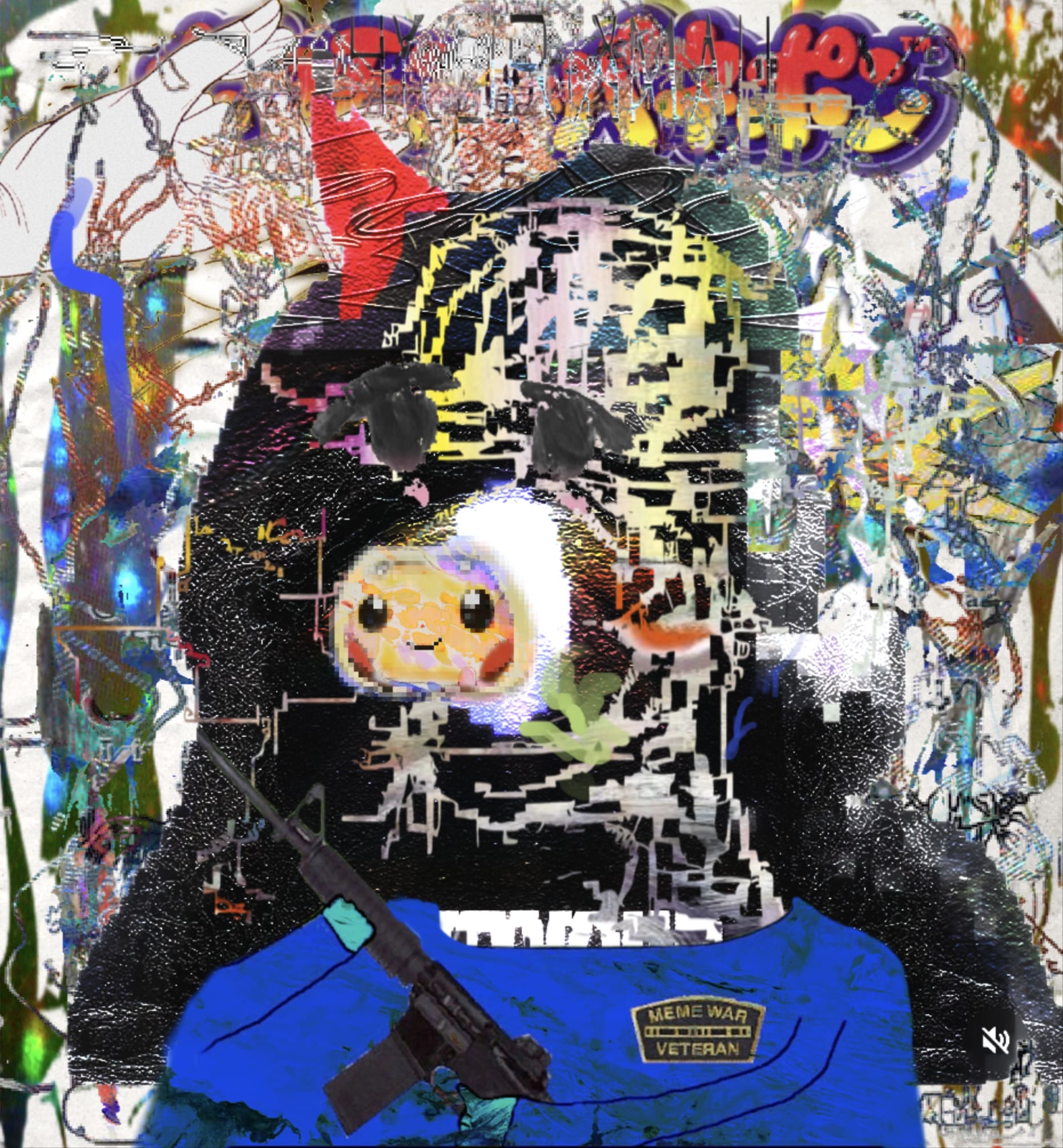
Drifella III: Room for Complexity
Peter Bauman (Monk Antony) considers how Drifella III by Evil Biscuit subverts the derided PFP to build a room-scale triptych of painterly compositions, internet meme-language and dark jester license, colliding into a complex record of life in the 2020s.
“...whether 2 embrace the light of Sylveon or the darkness of Umbreon.
Drifella poses this same ideology with resurrection. use a milady soul and be light and infinite on the network forever, but use a mifella and your dratini will turn into the dark jester known as DriFella”
-evil biscuit on Drifella (March, 2023)
It’s immediately apparent that Evil Biscuit’s Drifella III resists simplicity and surface-level understanding.
Nothing about the collection is simple. It’s not work for scrolling or glancing or “getting” right away. It’s a series of 1,333 rooms containing 3,999 chaos-layered, reference-maxxed paintings. Each room is a triptych containing up to 78 different traits; by comparison, CryptoPunks uses 87 traits in its entire 10K collection. Drifella III has over 5,000 traits.

These numbers may begin to explain the complexity of the project but still fail. It’s room-size work that demands room-size attention, but it also demands room for emotional variance. One piece might make you laugh, another cringe, while another leaves your jaw on the floor.
But the pain is worth it. Art we remember about a time speaks precisely to that moment, imperfections and all. Think how Richard Hamilton’s collage work defined the British post-war consumer society or how Warhol’s Marilyn Diptych captured the rise of mass media in 1960s America.
What’s exciting about Drifella III is how uncannily well it captures our chaos-layered times in those pop art traditions.
It succeeds by bringing in so many. You like twentieth-century painting and drawing? Regarded film? High fashion? None of that? Okay, what about manga? Video games? Memes? Experimental music? Anime or cartoons? You hate what your parents love?
You don’t need to have ever stepped foot in a museum to enjoy this work but those that have will discover Easter eggs (“Wait, is that a Rochegrosse?”) that the video game appreciator might not. But the video game appreciator will find things to love the art nerd will miss, while the manga lover… and so on and so on.
In fact, there’s probably only one thing that painting, film, music, Pokemon and video game lovers all agree on: that NFTs, and animal PFPs in particular, are about as uncool as it gets.
Nothing could signify faster or more concretely an unseriousness to the general public than an unserious cartoon PFP. Try getting a follow from Tina Rivers Ryan as zombie Lazy Lion #245.
So what would it mean to make serious art with these supposedly unserious tools?
What the most accomplished artists can achieve is communicating their most personal, inner lives for others to access. It’s difficult and rare and beautiful for artists to put all of themselves, every drop they can muster, into their work. When they also have a similarly rare comprehension of culture, both high and low, and a transcendent eye for painterly composition with the tools of their time, you have something special. Drifella III is special.
Comprehension of Culture
Below I break down Drifella III’s ability to comprehend and communicate high and low culture. Then we look at what its fusion of the painterly, internet chaos and scene-specific lore reveals about how contemporary Solana avant scene artists are using the “sediment” of online life to construct a new kind of cultural self-portrait for the 2020s.
Painting
With explicit references to Francis Bacon, Mark Rothko, Willem de Kooning, Paul McCarthy, Frank Frazetta and more, the artist clearly loves painting and a bit of its history. But more importantly, they possess a refreshing understanding of the fundamentals of painting and composition—balance, unity, palette, form, space—but within a networked condition.
With curious characters of cuckcore lore like the various crucifellas, painterly references to Bacon crystallize. Bacon created many of his own crucifixion paintings throughout his career, employing it as a horrifying vessel to express the most morbidly extreme, universal human emotions. But they were also about individual, real suffering.
Bacon said of his famous depictions, “Well, there have been so very many great pictures in European art of the Crucifixion that it’s a magnificent armature on which you can hang all types of feelings and sensations.” Biscuit uses networked art to take this idea even further, hanging the feelings and sensations of online life onto this ancient symbol, reinterpreting it twenty-one centuries later through the visual language of the internet as a pixelated cartoon. Bacon’s horrifying pain has been visibly subverted but we all understand, if you’ve ever used the internet, that the individual pain is still there beneath the surface.
Illustration
Beyond painting, illustration is clearly important to the artist, with several scattered allusions to illustrators like Sam Booker, Pendleton Ward and Akira Toriyama and their many characters. Drifella III also has nearly as many “pencil” traits as it does “paint.” By trait, I also mean the layers the artist employs to construct their painterly aesthetic with the tool HashLips; rather than painting with individual brushstrokes, Biscuit paints with layers of PNGs, misusing the untouchably uncool PFP maker.
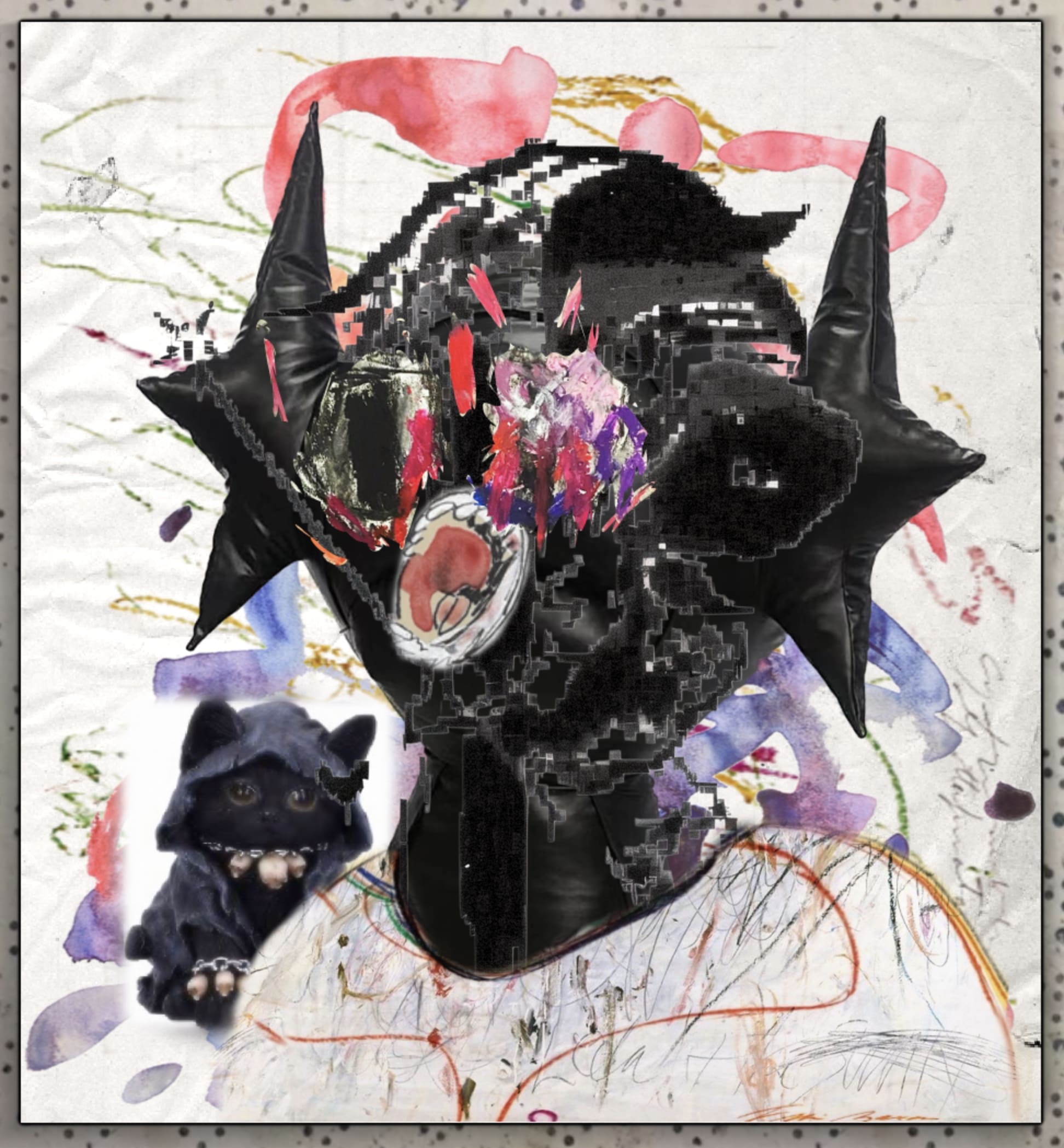
For example, #1075 (above) features an abstract “pencil” PNG layer, discernible through the gestural handwriting at the lower right and the assertive green scratches at the upper left. Overlaid is a “paint” PNG layer, noticed by sweeping strokes surrounding the central Dratini head, most strikingly the broad, watery reds above and the swift blue and violet gestures beneath. And look out for the dangerous “cat thief” by the figure’s shoulder to the left! The flatness of the chaotic pencil scrawl and the painterly brushwork surprisingly unifies the collage amidst the chaos. It’s so unified that if we were to scroll past this image on a feed, we’d likely think the shirt above is somehow part of the background. But the shirt type is “bacon8,” meaning its design comes from a separate but similar painting, either by or inspired by you-know-who.
Scene references
But the work does not just refer to the painting and drawing of art history. Biscuit described Drifella in a March 2023 tweet as “a punk mash-up of milady. Mifella and Dratini.” It’s thus most inspired by its own Remilia-Solana-VVV scene and lore, with ample references to some of Biscuit’s favorite artists, who, uncoincidentally, also dabble in painting.
Milady
While not the most important inspiration (that’s Mifella), Milady, from the pre-schism ETH Remilia days, still stands as the spiritual successor to nearly all of this Solana avant work. This is evident in the collection’s traits, where Milady and its derivatives appear more than just about any non-Drifella work. Milady, itself inspired by Japanese fashion and street culture, can be seen in crossover compositions, like in #641, wearing a Dratini poncho.
Milady Derivs
Partly what made Milady so relevant was how its many derivatives catalyzed the scene and propelled it forward creatively. Drifella III acknowledges this lineage with multiple references to Milady “derivs,” especially Pixel Miladies. This piece in the altarpiece “holy frame,” for example, references both Milad and Milady, That B.I.T.C.H., two Milady derivs in one. They’re presented with an original Drifella at the bottom. By placing these avant scene characters in a religious altarpiece frame, the artist is not so subtly equating these figures to the gods and saints of cuckcore lore.
Mifella
“Wait, wait!” I hear you, “Drifella is about Mifella!” After all, a Drifella, according to lore, is the soul of Mifella in a passed Dratini body. Mifella makes frequent appearances throughout, including as “biscuit mifella” in Drifella III #777's gilded brass frame.
Mifella lore even helps explain how Drifella III came to be in the first place. Mifella stands as a fork in the road for the avant scene where a faction essentially split and went to Solana from Ethereum. According to early scene lore, told to me by Patrician, Mifella was struggling to mint out on Solana as the first of its kind on this new chain. The community began riffing that Mifella would only mint out once the artist died. That led to the joke that Mifella sacrificed himself to birth the scene, resulting directly in crucifella, which would first appear in The Constant Fella, also by Biscuit, and is considered Mifella 1.5 by some.

Without crucifella, there is no Drifella III, according to writer and artist Lowbie, as a large-scale physical crucidrifella (a deriv, of course) from Yeche Lange's show Haircuts helped inspire a series that forwarded the painterly elements of the previous Drifella projects at a large scale.
Mifella derivs
Two important inspirations for Biscuit’s exquisite use of chaos layering in Drifella III are Mifella 2 and Cuckfella, both derivatives of Mifella and two notoriously visually chaotic projects. Biscuit told me how both “are good projects to take a look at and compare the chaos layering.” The images can be so textured that the faces become completely obscured. It was inspiration from these projects that propelled the more distorted and unrecognizable turn from Drifella 2 to III.
And more
Other artists like Super Metal Bosch, Wretched Worm, Luhfella and Parker Ito also have their work referenced in Drifella III, with characters like Luhfella and Drilady sometimes visible in the “holy frame” works, placing these characters in the familiar honorary position. In addition to the scene’s lovely characters, the work also draws from the painting of artists like Earl and Spiky DJ, creator of Mifella. Often their work is presented mostly intact with minimal additional layers.
Biscuit’s personal work
In addition to the endogamy outlined above, more than anything else, Drifella 1 and 2 spiral in the eye of the hurricane that is Drifella III. These projects, like other cuckcore projects, are steeped in lore, which is getting crystallized now by the artist with writers like SonofLasG.
A fascinating visual development in the evolution of Drifella across the three series, as the hurricane analogy implies, is its apparent descent into madness, or maybe that’s just adulthood. Many original Drifellas are more clear-eyed and sharp, with a youthful energy that gets distorted in a more mature Drifella 2. By Drifella III, the Dratini forms are barely recognizable, due to its extensive layers of brush and pencil work.
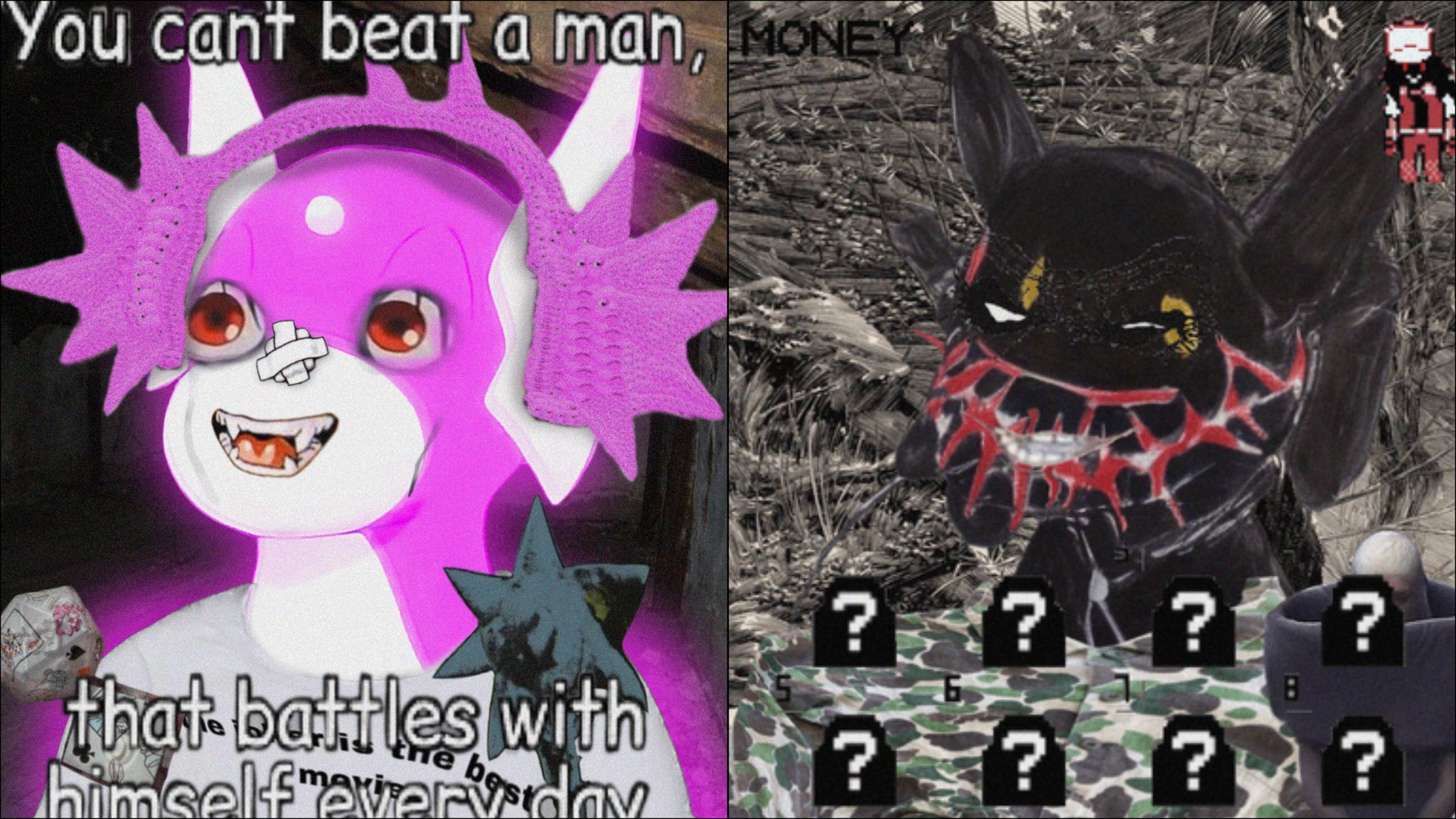
Earlier iterations of Drifella III had fewer of these paint layers; the artist told me, “At first they were looking too close to drif 2 and you could see the dratini silhouette too clearly.” Biscuit continues, “These still look good but don’t have nearly as many extra paint layers.”

From their own paint layers to the dozens of painters and contemporary artists Drifella references, it’s clearly a project steeped in a painterly, fine art culture. But is that all there is to it?
Culture Blender
Not all culture is “high” culture, self-consciously presenting itself as art. Fascinatingly, the Drifella III culture blender is comfortable with fine art being deliberately placed at the same level as internet memes, Pokemon, film, music, fashion, anime, manga and video games. The artist mixes high and low but also digital and IRL.
It’s like an online Christoph Büchel exhibition with Yves Klein masterpieces strewn beside bric-a-brac. It also recalls the darker, early British pop art of Eduardo Paolozzi, who collaged comic strips, advertisements and machine parts to expose the anxiety and allure of postwar consumer culture, a sensibility Drifella’s mishmash updates with our new anxieties and desires.
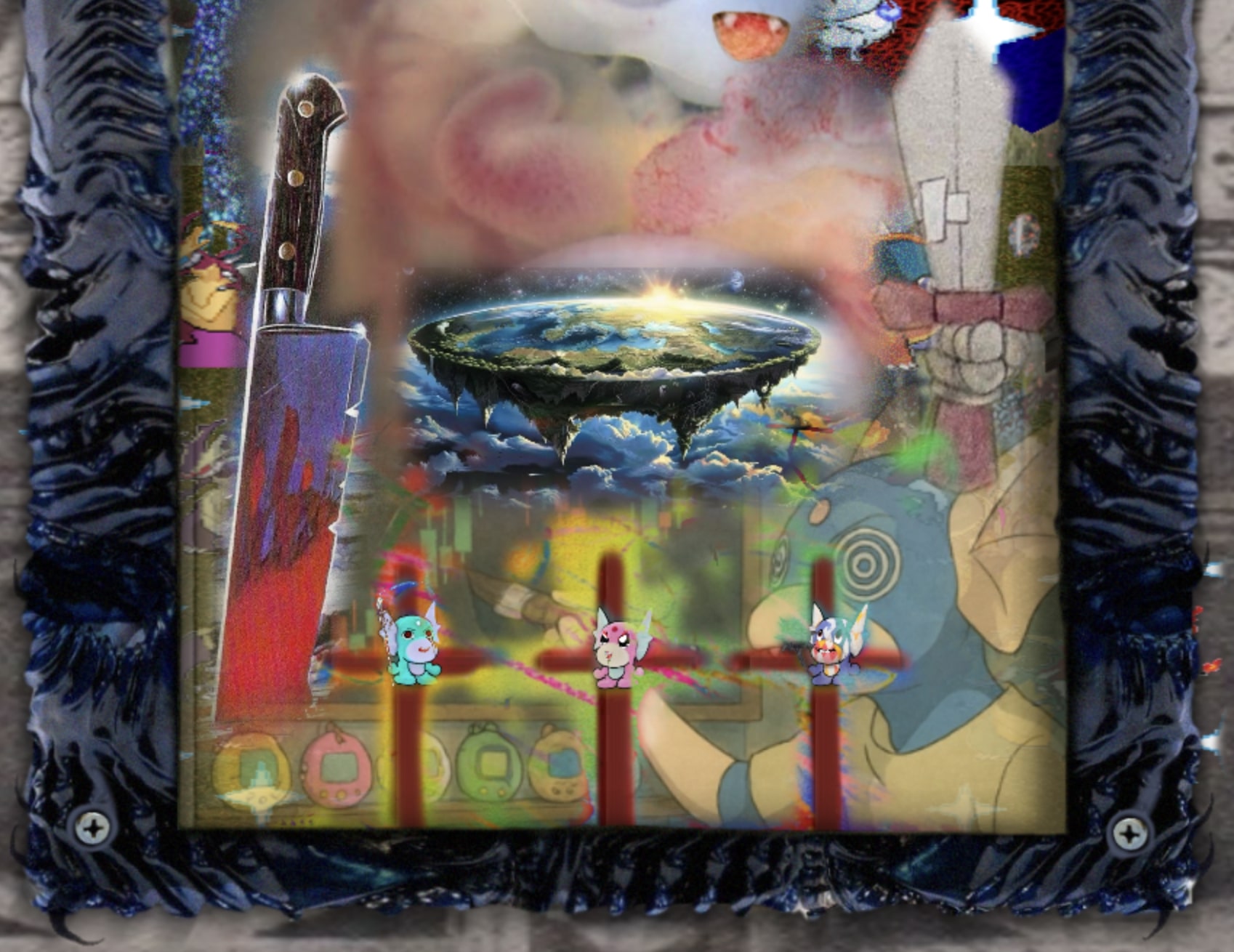
Placing high and low together, the artist is asking whether you’re scrolling too fast to know the difference. Is there even a difference? What does the juxtaposition of Naruto and Rothko say about our lives in 2025? Changing art world habits? The work shows how internet-age cultural memory is constructed from our fraying experience, plus the tension between digital (memetic) and physical (painterly) worlds. But it also shows how transitive this memory is and that while its values may acknowledge twentieth-century painting, there remains the sense that the broader work of the avant scene signifies a conscious departure.
Internet culture, memes and Blockchain
Central to the fluency of Drifella as a language of culture is its extensive incorporation and understanding of our digital world, especially memes and Internet culture. This includes memetic touchstone-inside-jokes like Kanye and Twilight as well as the deepest depths of Solana, NFT, PFP and meme coin culture.
Music
Understanding Drifella's roots in punk is also central to the work. Biscuit puts it like this: “for the true power of DriFella lies in the complex interplay between the base-cocoon-maturity structure, the Godhead-pilled take on the Dratini line, and the chaotic, punk-inspired art that defines its very essence.” The artist has even described Drifella as a “lil punk” on Twitter. That unlock helps explain Drifella’s angst better, its rambunctious, rebellious rawness, its willingness to confront and provoke. The work, as with the Solana avant-VVV scene more broadly, also demonstrates the ethos of making your own culture rather than consuming what’s popularly on offer.
This article would be a 10K-word listicle if I went through each ingredient in Drifella’s culture blender. It leaves plenty to explore for the reader. Besides what the work is and references, it also matters how we consume the culture smoothie pouring from the blender.
Rooms and Triptychs
The artist presents us with a culture blender but not as individual images. That’s a bit too easy. At the very least, it’s fairly well-trod territory in art history, let alone with Drifella 1 and 2. Instead, we’re presented with triptychs in rooms. This means viewing the collection in any feed is unsuitable. To experience the collection as intended, it should be viewed on d347h.eth’s custom frontend, Drifellascape.
Rooms
Taking nothing away from Drifella 1 and 2 [Jared Madere called Drifella 2 the most interesting conversation in painting in 30 years], but the form alone of the room makes a demand on the viewer that a single, even traitmaxxed, image simply cannot. A room is not for a feed but for room-scale attention. You wouldn’t walk past a triptych on a gallery wall in 0.5 seconds.
Drifella III further encourages this patience with its spatial framing. Not only are there three impossibly dense artworks to visually and mentally parse, there’s also the wall and its decor, the ground, and the toys scattered on the floor. These details build the worlds, recalling Richard Hamilton’s interiors and Cézanne’s still lifes.
British pop artist Richard Hamilton was one of the earliest to recognize that “all art is equal,” from bawdy images to TV and painting. His brushstrokes were the day’s most relevant and curated pop culture objects, including the latest technology, like vacuum cleaners, even risque pin-ups.

Hamilton placed them together and in rooms to emphasize how these external phenomena actually are part of our most intimate spaces; they fundamentally shape everyday life; they are us; we become them.
Drifella III’s use of rooms, now depicted on screens, plays a similar role: they create a public cultural atmosphere within an intimate space, bringing attention to how what we consume ultimately consumes us.
Like any real room, items clutter the floor, adding to the feeling that we are meant to think about these rooms like Cézanne asked us to think about his still lifes: as transitive, shifting, even if they appear still. Like Cézanne juxtaposed rotting apples with fresh ones, Drifella III’s scattered objects suggest a living, changing world shaped by our own perspective, the relationships between things and not just their isolated forms.
Finally, setting Drifella III in rooms is also an ode to Gallery Yeche Lange, which often itself has miscellaneous figures beside hung objects and was instrumental in Biscuit and Drifella III’s development.
Triptychs
The choice to make the work triptychs serves many purposes as well. Most directly, it’s a way to “up the ante on drif 2 since this would be the final of the trilogy,” as the artist told me, from the single-image Drifella 1 and 2. It’s also clearly a play on the series being a trilogy and this being the third iteration.
But critically, triptychs hammer home the religious—and life and death—symbolism found throughout the collection, as they historically have been associated with religious painting. As with placing the work in rooms, making them triptychs also requires that extra devotion from the viewer. To view each piece and its details and references but to also consider it in relation to its other parts in space. This is truly what enthralls about Drifella III, as you feel compelled to go full screen, yearning for the work to be wall-sized in real life.

Now that we’re comfortable in the room and we’ve enjoyed our culture blender smoothie, let’s look at what else the work might be telling us.
Masks, Adolescence & Online Self
A Dratini, in Pokemon lore, is a fast-growing child dragon that evolves into a mighty Dragonite. But remember the quote at the beginning? Drifella may have an adolescent Dratini body but it has the dark jester soul of Mifella. Wait a minute, is this all really a coming-of-age story?
Pokemon’s Dratini character is thus fundamental to both the lore and aesthetics of Drifella III. Reading the original DriFella description further supports the claim that the entire series could be read as the artist’s personal coming-of-age journey. It begins: “Dratini, your faithful companion and friend, has tragically passed away, leaving you heartbroken and desolate. Yet, in your darkest hour…”
Here we get a glimpse at the themes of desolation and darkness vividly explored in Drifella III thanks to its dark jester soul, which comes with a certain license. Historically, the jester had a unique role: speaking truths at court that others couldn’t, using humor, parody, absurdity.
Like any role, though, it’s not a pure representation of our inner selves. It’s social performance, a type of mask.
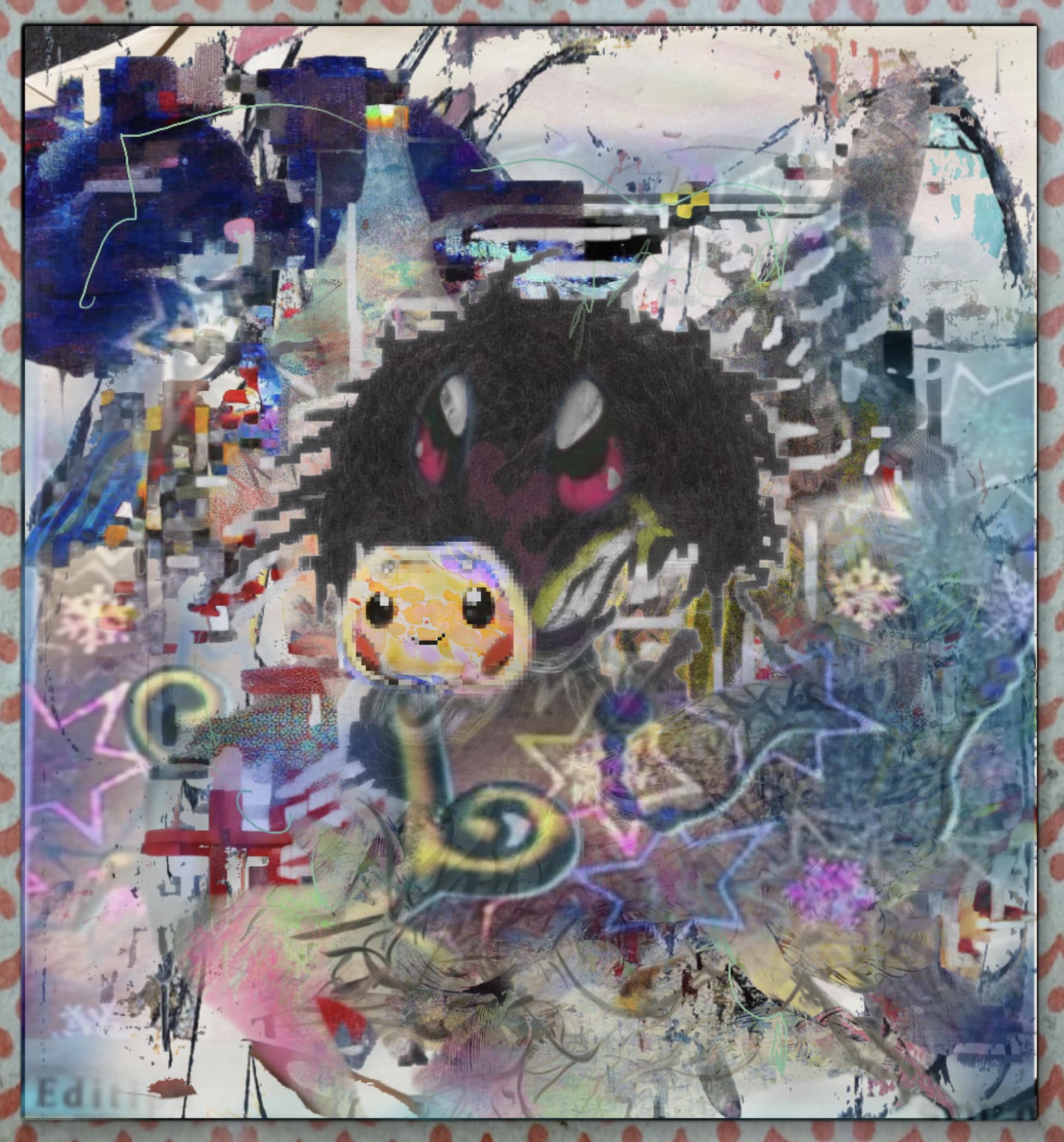
Masks
Masking is a key motif throughout the Drifella trilogy, cutting to deep questions about online identities and their increasing relevance, if not dominance, in the lives of many, especially the terminally online NFT crowd. Biscuit told me how it’s about “using masks for alt accounts and having a pfp like milady that replaces your identity completely.” We can get so carried away in these communities that the mask can appear to never come off. What we consume consumes us.
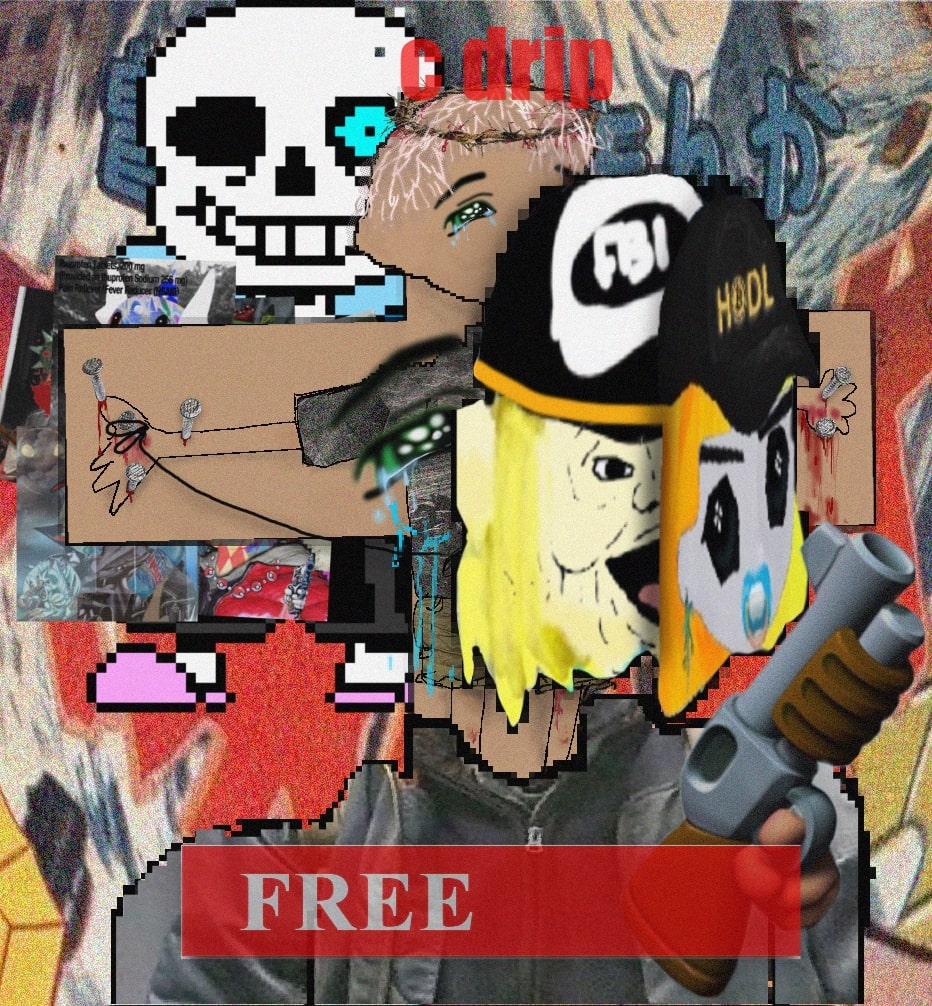
Masks have been important to Biscuit since at least their work on The Constant Fella. The artist shared the image above with me, saying, “this trait specifically is a crucimifella with a Charlotte Fang mask with a remilio baby mask overtop. he is known for having a bunch of masks.” These masks come to symbolize the hazy Crypto Twitter world of alt accounts, pseudonymity and cultish sub-communities, all three known quite well by the artist themselves.
Another aspect that masks hint at is emotions bubbling beneath the placid dragon’s surface, occasionally violently bursting through with a fiery flare and brilliance. But it can also be something darker. This is a volatile teen dragon we’re dealing with.
Combativeness/Weapons/Violence/Bloodshed
Two types of violence permeate Drifella III: one direct and one more conceptual.
Despite some current and horrifically tragic exceptions, few people alive today have directly experienced war. Nonetheless, we’re constantly inundated with violence and violent images with untold consequences on our mental health and psyches. What richer terrain for art, explaining the various ways Drifella III conveys this imagery from blood splats to various weaponry.
But combativeness in the work is not only superficial. It also speaks to the sense of irony and deep cynicism of young people on the internet who look towards the future and understandably don’t love what they see. They feel more alive online but know they maybe shouldn’t; the outer turmoil of the work mirrors a generation’s inner angst.

Male Loneliness
As our online identities consume us, our IRL selves can suffer. Since 2023, social isolation has been considered an epidemic in the United States. Findings show that “young men in America are among the loneliest and that there are five times as many men who say they have no close friends as there were in 1990.” The social fabric of a country and generation is ripping before our eyes.
As noted, these dragons depicted in Drifella III are just teens (“you nurtured them into teenhood,” the collection description reads), supporting the thesis that this work can be, well, teen-like: immature, mean, raw, unsure, unexpectedly sweet and funny but with extreme emotional swings.
Drifella overtly addresses these issues through its richly layered dragon portraits, or self-portraits? It's a turbulent coming-of-age drama that combines the adolescent volatility of a teen dragon with the performative masks of online life. It asks what might be under the mask, simmering beneath the jester’s sly grin.
Challenges
What I often really mean when I say “I like this work” is that it has affected me. I think about it a lot. I look at it a lot. It makes me think of things. It has unequivocally changed me, my thoughts and actions. One major reason this work has stayed with me is because it challenges me. Great art should challenge you. It resists being understood quickly. You won’t walk away the same afterwards or be the same person post-viewing. It challenges me exactly because I don’t understand everything. I can’t. We can't. It challenges me also because I don't condone everything.
Not all culture is beautiful
The presence of crude words and immature edgelord imagery in Drifella are not provocations for their own sake. Drifella is the dark jester: free to say the unsayable so that the culture can inspect itself, decide for itself. In that spirit we are invited to think of these unsavory images less as endorsements and more as honest records of what actually circulates online and in group chats. It’s the visual and verbal sediment of three decades online. The jester’s license comes with risks, though. Repetition can desensitize and audiences harmed by certain verbiage may find the jokes retraumatizing.
You’ve come across the sediment reading comment sections, 4chan or Reddit. The internet is as dark a place as the human soul that it reflects. It didn’t make itself. It is us and this is, perhaps troll farms aside, simply what we do and who we are as humans. We like to get in the muck.
But the work's seriousness is its ability to make that sediment visible in a painterly frame and context, opening up a discussion for community and critical analysis because it treats it honestly. These images, language and behavior exist out there. After you’re done chuckling or cringing, it asks us to question why, what can and can’t be done about it and simply what it says about us.
Serious art can be unserious; it can come from unserious means; it unsettles; it doesn’t confirm.
Closing
So, what did I miss? A hundred things? Surely more like a thousand. Over 4,000 words in (think about how there are hundreds more Drifella III traits than words in this article) and I’ve barely scratched the surface if we’re honest.
What do ALL these seemingly infinite references tell us? Maybe it’s to remind us of an idea, rooted in Pokemon’s and the original Drifella's lore. I began this piece with the second half of the quotation. Here it is now in full:
“The philosophy of Eevee and its Eeveelutions is a complex one, rooted in the very nature of life itself. Life presents us with infinite possibilities, and Eevee embodies this idea in its unique ability to evolve into different forms based on the choices it makes.
whether 2 embrace the light of Sylveon or the darkness of Umbreon.
Drifella poses this same ideology with resurrection. use a milady soul and be light and infinite on the network forever, but use a mifella and your dratini will turn into the dark jester known as DriFella”
It’s the idea that who we are lies beneath the masks, souls navigating light and darkness, online and off, shaped by everything we consume. Drifella III reflects that process of life and art “infinite on the network forever" and ever.
-----
Peter Bauman (Monk Antony) is Le Random's editor in chief.




